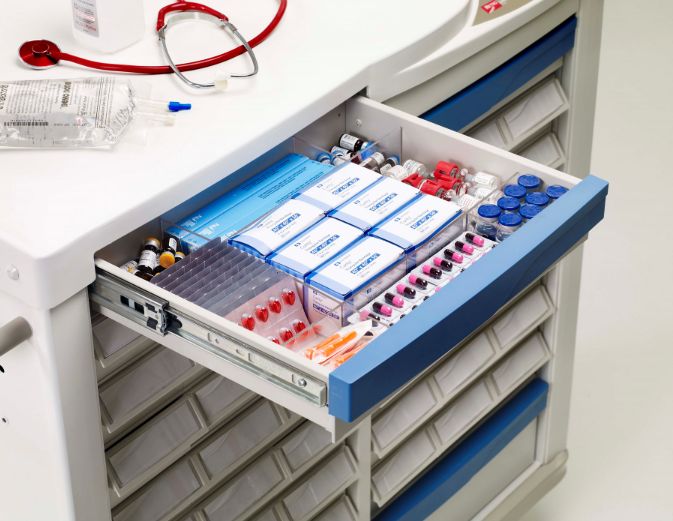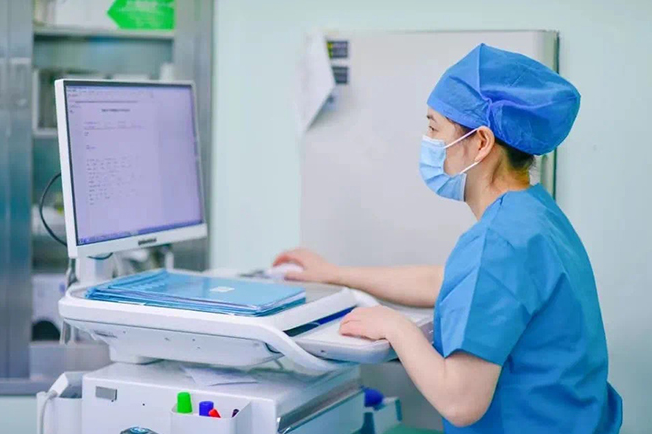Definition of a Medical Cart
Medical carts are mobile storage units that many healthcare settings use. You’ll find them in hospitals, clinics, and care homes. I’ve seen these medical carts help staff organize and move supplies, medications, and equipment needed for patient care.
Types of Medical Carts
Medical carts come in many designs to meet different medical needs. I’ve seen many types of carts used in hospitals and clinics. Here are the common types:
Anesthesia Carts: These hold anesthesia supplies. Doctors can grab what they need fast during surgery.
Emergency/Crash Carts: These have tools and medicines to save lives. Medical staff use them in emergencies.
Procedure Carts: These hold tools for specific medical tasks. They help make procedures faster and more efficient.
Medication Carts: These store and organize medicines. They often have locks and barcode readers for safety.
Treatment Carts: All-purpose carts that carry supplies for basic patient care like bandages and wound care items.
Supply Carts: These move medical supplies between hospital areas.
IV Carts: These store IV supplies like tubes, fluids, and needles.
Key Features of Medical Carts
Mobility
Made with swivel casters for easy movement in tight spaces.
Many carts have locking wheels to keep them steady when not moving.
Storage Capacity
Contains many drawers, shelves, and sections for organizing medical supplies.
You can customize drawer layouts to match your needs.
Power Options
Comes with built-in power strips and battery systems for power needs.
Some carts run up to 12+ hours for electronic devices.
Ergonomics design
Has height-adjustable work surfaces, easy-grip handles, and flexible monitor mounts.
I find these features make the cart comfortable for all staff members.
Durability
Made from strong materials like aluminum, steel, or tough plastics.
These materials stand up to constant use in medical settings.
Extra accessories addable
You can add extras like IV poles, sharps bins, waste containers, and scanner holders.
I recommend these add-ons to make your cart more useful for specific tasks.
Benefits of Medical Carts
| Benefits | Details |
|---|---|
| Improved Efficiency and Workflow | Medical carts boost workflow by bringing supplies and patient records to the bedside.
Staff spend less time walking to storage rooms, speeding up work. Studies show mobile carts reduce documentation time by up to 30%. Carts cut nurses’ walking distance by up to 50% per shift. One study showed direct patient care time increased from 31% to 41% of a nurse’s day, improving output. |
| Enhanced Patient Care | Quick access to tools allows providers to spend more time with patients.
Teams respond faster to patient needs, enhancing care quality. |
| Reduced Errors | Mobile carts support real-time notes and administering medication.
Staff rely less on memory, reducing mistakes. |
| Increased Safety | Height-adjustable features and intuitive handles reduce strain from bending and lifting.
Good designs minimize staff injury risks. |
| Cost Savings | Improved staff efficiency and fewer errors save hospitals money.
Optimized workflows help teams use time and resources more effectively. |
| Flexibility and Customization | Medical carts can be customized with different drawers and technologies.
They adapt to the specific needs of any department or task. |
| Improved Patient Satisfaction | Mobile stations allow doctors to maintain eye contact with patients while accessing records.
This improves communication and makes patients feel better about their care. |
Common Uses of Medical Carts
Medication Administration
Medical carts store and move medications to patient rooms. They often feature:
– Locking drawers to keep drugs safe.
– Barcode scanners that help give the right medications.
– Record-keeping systems for tracking all medications given.
Emergency Response
Emergency or “crash carts” help staff respond quickly in critical situations. These carts include:
– Heart restart devices and breathing tubes for heart attacks.
– Life-saving drugs for urgent care needs.
Procedure Support
Medical carts help with bedside care by keeping supplies in one place:
– Gauze, cleaners, and sterile tools.
– Tools needed for wound care, putting in tubes, or starting IVs.
Point-of-Care Testing
Testing carts allow staff to run tests right at the patient’s bedside. I find these tools very helpful for:
– Blood sugar checks.
– Urine tests and other quick tests.
Computer Workstations
Carts work as moving desk spaces with:
– Computers or tablets for looking up patient records.
– Tools for writing orders and notes while caring for patients.
Isolation Precautions
Special carts carry protective gear (PPE), such as:
– Gowns, gloves, and masks for rooms where patients must be kept apart from others.
Anesthesia Support
In surgery and procedure rooms, special carts carry:
– Sleep drugs and tools.
– Safety checking tools to watch patients during surgery.
Supply Transport
Basic carts help move things around the hospital by:
– Bringing new supplies to nursing areas.
– Moving items between hospital sections quickly.
Patient Transport
Special carts help move patients around safely. I’ve seen these carts include:
– Oxygen tanks, heart rate monitors, and spaces for patient charts.
Why Medical Trolley Carts Are Essential In The Healthcare Sector?
I’ve found medical carts produced by Grace Medy vital in today’s healthcare settings. They boost efficiency, safety, and patient care. Here’s why I think medical carts matter so much:
1. Better Efficiency and Workflow
Medical carts save time by bringing supplies and equipment to patients’ bedsides.
Studies show these carts cut nursing walking distance by up to 30%. This saves time and improves patient care.
2. Better Patient Safety
Medication carts have locks that help stop medication errors and keep controlled substances secure.
The neat, secure storage in these carts helps lower patient risks during care.
3. Fighting Infection
Isolation carts help stop germs from spreading in health centers.
Their easy-clean surfaces help stop infectious diseases from spreading.
4. Bedside Care Made Easy
Mobile workstations in medical carts let staff check health records and enter data at the patient’s side.
This makes for real-time notes and more exact patient care.
5. Quick Emergency Help
Crash carts carry life-saving drugs and tools, helping staff respond in emergencies.
6. Proven Results
Medication carts cut drug giving errors by 25-30%.
89% of nurses say mobile carts make their work flow better and improve patient care.
7. Growing Use
Medical carts are used in 98% of hospitals and 78% of outpatient centers worldwide.
The market will grow to $4.7 billion by 2030 (13% CAGR). Their role in healthcare keeps growing.
I’ve seen how medical carts tackle key health care issues like efficiency, safety, and infection control. They’re now key tools for better care in health centers.



